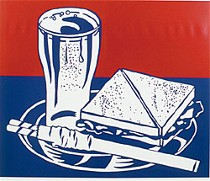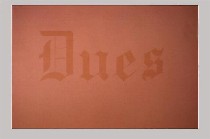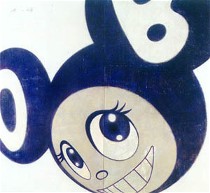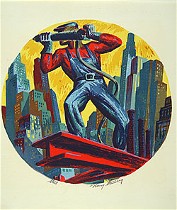 Screenprints and stencils are suddenly all the rage in art shows. The Asian Arts Initiative had a political art show back in the spring, right before we went into business; the show included a bunch of stencil art; then Space 1026 had a all-stencil show, most of it political. And coming up Friday at the Painted Bride , “Say Something: The Art of Politics,” curated by Philadelphia artist Cavin Jones. The notes mutter something about the Patriot Act and freedom of speech.
Screenprints and stencils are suddenly all the rage in art shows. The Asian Arts Initiative had a political art show back in the spring, right before we went into business; the show included a bunch of stencil art; then Space 1026 had a all-stencil show, most of it political. And coming up Friday at the Painted Bride , “Say Something: The Art of Politics,” curated by Philadelphia artist Cavin Jones. The notes mutter something about the Patriot Act and freedom of speech.
If there aren’t any screen prints or stencils in that show, there ought to be.
But right now the Art Museum has a show of screenprints–a form of stencil art–from the museum’s own collection: Popular, Pop & Post-Pop: Color Screenprints 1930s to Now, that runs to Jan. 25.
The show is in the Berman and Stieglitz galleries, the space across the the museum store run by the print department, and it’s an eye opener.
 If you’ve ever done screen prints and you thought they were the perfect medium for t-shirts, you’re selling them short. Here are just a handful of the artists who tried their hand at the medium and are included in the show: Roy Lichtenstein (shown, “Untitled [Sandwich and Soda]”) Ben Shahn, Takashi Murakami, Kara Walker, Ed Ruscha, Betye Saar, Lucas Samaras, Andy Warhol of course, Jim Houser, Willie Stokes, Randy Bolton, Bridget Riley, Edna Andrade, James Rosenquist, and Robert Gwathmey.
If you’ve ever done screen prints and you thought they were the perfect medium for t-shirts, you’re selling them short. Here are just a handful of the artists who tried their hand at the medium and are included in the show: Roy Lichtenstein (shown, “Untitled [Sandwich and Soda]”) Ben Shahn, Takashi Murakami, Kara Walker, Ed Ruscha, Betye Saar, Lucas Samaras, Andy Warhol of course, Jim Houser, Willie Stokes, Randy Bolton, Bridget Riley, Edna Andrade, James Rosenquist, and Robert Gwathmey.
The show’s pairings were provocative and exciting.
Ed Ruscha’s “Dues” (shown) and “Mews,” screen printed using homemade potions of fruit juices and such that faded over time to white-on-white images of the words, hung next to Betye Saar’s “Passe Blanc,” a bleached-out woman of color, dressed in white on a white ground.
And across from that was Kara Walker’s “The Emancipation Approximation,” with a pair of flat silhouetted women–apparently also of African descent–trapped in tightly-bodiced dresses with bouffant skirts, one woman above the inverted other.
 Takashi Murakami’s flat, quadruplicate “Mr. DOB” images of cartoon/anime mice (shown, a Mr. DOB image not in the museum’s collection) talked to Kara Walker’s superflat areas of pigment, but Mr. DOB was definitely more comical and cultural than political. British pop artist Bridget Riley’s black and white concentric rings hung next to an undulating checkerboard from Philadelphian Edna Andrade, and the content was definitely optical effects.
Takashi Murakami’s flat, quadruplicate “Mr. DOB” images of cartoon/anime mice (shown, a Mr. DOB image not in the museum’s collection) talked to Kara Walker’s superflat areas of pigment, but Mr. DOB was definitely more comical and cultural than political. British pop artist Bridget Riley’s black and white concentric rings hung next to an undulating checkerboard from Philadelphian Edna Andrade, and the content was definitely optical effects.
And speaking of quadruplicate, the Andy Warhol images implied multiples even when the multiples were not there. And advertising images like “Tux Pale Dry Ginger Ale” and “Hygrade Ham” served as reminders of silkscreen’s commercial uses.
 Going further back in time, Sylvia Wald’s “Tundra” was a wonder of textures in a medium famous for its flat areas and hard edges, and an abstract landscape to boot. The show included Works Progress Administration era art–political for sure, including Eugene Morley’s dark (in content, not color) “Execution,” and influential printmaker Harry Sternberg’s “Steel (or The Riveter)” (shown).
Going further back in time, Sylvia Wald’s “Tundra” was a wonder of textures in a medium famous for its flat areas and hard edges, and an abstract landscape to boot. The show included Works Progress Administration era art–political for sure, including Eugene Morley’s dark (in content, not color) “Execution,” and influential printmaker Harry Sternberg’s “Steel (or The Riveter)” (shown).
Although the show may lack the glitz of the Elsa Schiaparelli “Shocking!” show, it is one of those shows that gives back however much time you sink into it and then some.









